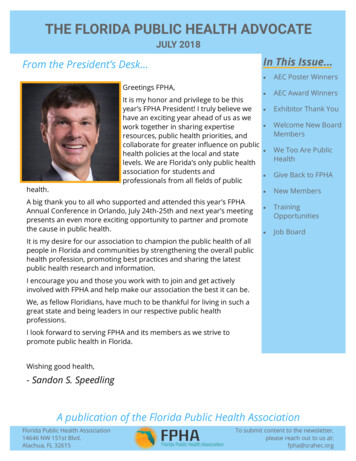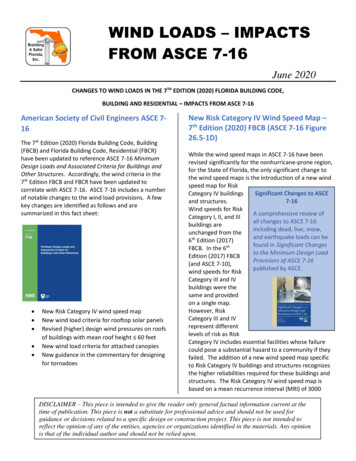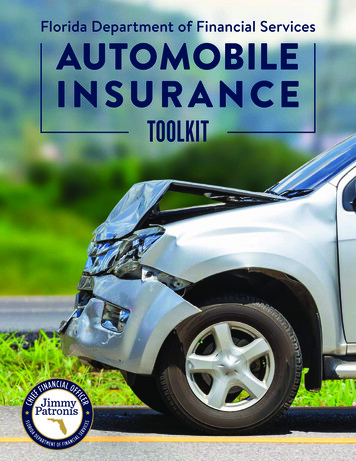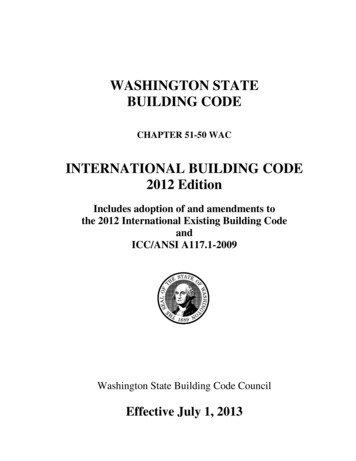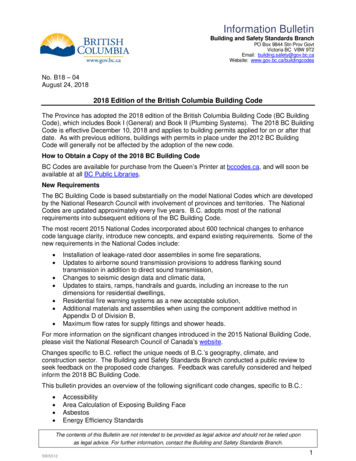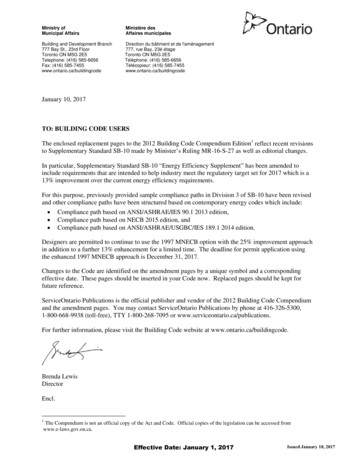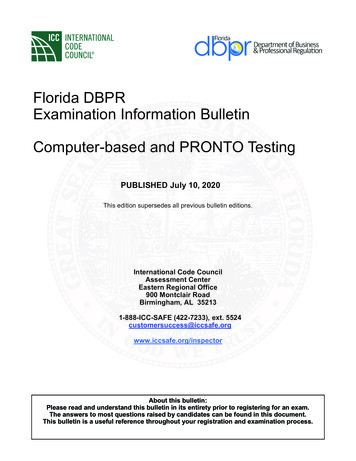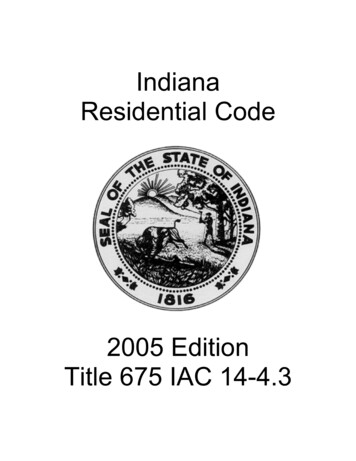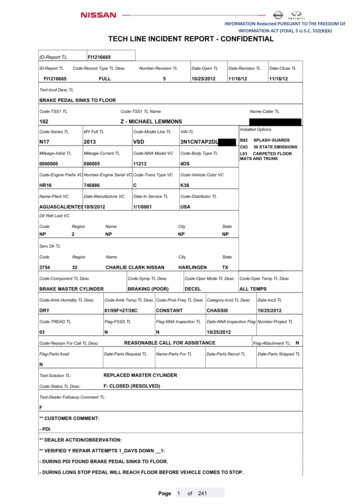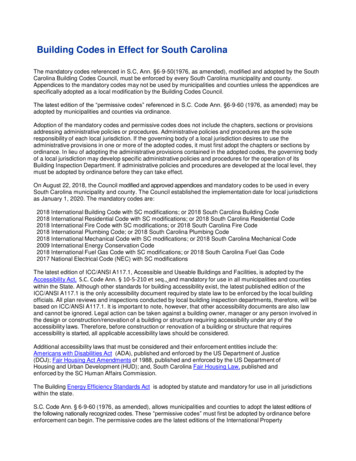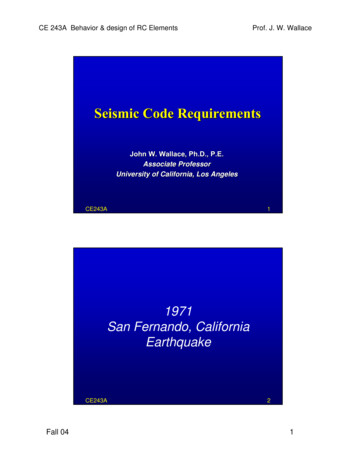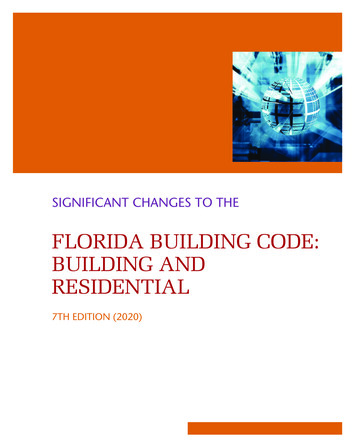
Transcription
SIGNIFICANT CHANGES TO THEFLORIDA BUILDING CODE:BUILDING ANDRESIDENTIAL7TH EDITION (2020)*2020 SignificantChangestotheFBC.indb 19/28/20 10:36 AM
SIGNIFICANT CHANGES TO THEFLORIDA BUILDING CODE:BUILDING AND RESIDENTIAL2020 EDITIONInternational Code CouncilISBN:978-1-952468-29-2Project Manager:Hamid NaderiPublications Manager:Anne F. KerrProject Editor:Rory ClevelandProduction Technician:Dianna LoganCover Design:Julia LangeICC Staff:Executive Vice President and Director ofBusiness Development:Mark A. JohnsonSenior Vice President, Business andProduct Development:Hamid NaderiVice President and Technical Director,Product and Services:Doug ThornburgSenior Marketing Specialist:Dianna HallmarkCOPYRIGHT 2020by INTERNATIONAL CODE COUNCIL, INC.ALL RIGHTS RESERVED.This publication is a copyrighted work owned by the International Code Council, Inc. (“ICC”).Without advance written permission from the ICC, no part of this publication may bereproduced, distributed or transmitted in any form or by any means, including, withoutlimitation, electronic, optical or mechanical means (by way of example, and not limitation,photocopying or recording by or in an information storage and retrieval system). Forinformation on use rights and permissions, please contact: ICC Publications, 4051 FlossmoorRoad, Country Club Hills, Illinois 60478; phone: 1-888-ICC-SAFE (422-7233).The information contained in this document is believed to be accurate; however, it is beingprovided for informational purposes only and is intended for use only as a guide. Publication ofthis document by the ICC should not be construed as the ICC engaging in or renderingengineering, legal or other professional services. Use of the information contained in thisworkbook should not be considered by the user as a substitute for the advice of a registeredprofessional engineer, attorney or other professional. If such advice is required, it should besought through the services of a registered professional engineer, licensed attorney or otherprofessional.Trademarks: “International Code Council,” the “International Code Council” logo, “ICC,” the“ICC” logo, “International Building Code,” “IBC” and other names and trademarks appearing inthis book are registered trademarks of the International Code Council, Inc., and/or its licensors(as applicable), and may not be used without permission.Errata on various ICC publications may be available at www.iccsafe.org/errata.First Printing: October 2020PRINTED IN THE USAT025690*2020 SignificantChangestotheFBC.indb 29/28/20 10:36 AM
ContentsSIGNIFICANT CHANGES TO THEFLORIDA BUILDING CODE: BUILDINGPART 1AdministrationChapters 1 and 2 2110.3Required Inspections3202Definition of “Sleeping Unit”6PART 2Building PlanningChapters 3 through 6 302.1Classification of Outdoor Areas310.5.2Owner-occupied Lodging Houses311.1.1Classification of Accessory Storage Spaces8 11 1315406.1Motor-vehicle-related Occupancies1620503.1.4Allowable Height and Areaof Occupied Roofs22Table 509Incidental Uses24602.3, 602.4.1FRT Wood Sheathing in Exterior WallAssemblies26PART 3Fire ProtectionChapters 7 through 99312.1Classification of CommunicationEquipment Structures420.7Corridor Protection in Assisted Living Units 422.6Electrical Systems in AmbulatoryCare Facilities 27Table 705.2Extent of Projections28713.8.1Membrane Penetrations of Shaft Enclosures30716.5.9.3Delayed-action Self-closing Doors31803.3Interior Finish Requirementsfor Heavy Timber Construction33903.3.1.2.3Protection of Attics in Group ROccupancies3418iii*2020 SignificantChangestotheFBC.indb 39/28/20 10:36 AM
iv CONTENTS 905.4Class I Standpipe Connection Locations37907.2.1Fire Alarms in Group A Occupancies39PART 5Building Envelope, Structural Systemsand Construction MaterialsChapters 12 through 26 PART 4Means of EgressChapter 10 Table 1004.5, 1004.8Occupant Load Calculationin Business Use Areas1006.2.1, Table 1006.2.1Group R Spaces with One Exitor Exit Access Doorway1006.3, 1006.3.1Egress through Adjacent Stories1008.2.3Illumination of the Exit Discharge1010.1.1Size of Doors1010.1.4.4Locking Arrangements in EducationalOccupancies40 41 43454749 521010.1.9.8Use of Delayed Egress Locking Systemsin Group E Classrooms541010.1.9.12Locks on Stairway Doors571010.3.2Security Access Turnstiles591013.2Floor Level Exit Sign Location621017.3, 202Measurement of Egress Travel631023.3.1Stairway Extensions651026.4, 1026.4.1Refuge Areas for Horizontal Exits671029.6, 1029.6.3, 202Open-air Assembly Seating69*2020 SignificantChangestotheFBC.indb 4 711206.2, 1206.3Engineering Analysis of SoundTransmission731504.3.3Metal Roof Shingles751507.1.1Underlayment (Sealed Roof Deck)761510.11Cable- and Raceway-type Wiring Methods851603.1Construction Documents861604.5.1Multiple Occupancies88Table 1607.1Live Loads for Balconies and Decks90Table 1607.1Live Load Reduction911607.14.2Minimum Live Load for Fire Walls941609Wind Loads951804.4Site Grading992207.1SJI Standard1012209.2Cantilevered Steel Storage Racks1032303.2.2Fire-retardant-treated Wood104Table 2304.9.3.2Mechanically Laminated Decking1062304.11Heavy Timber Construction1082304.12.2.5, 2304.12.2.6Supporting Members for PermeableFloors and Roofs1139/28/20 10:36 AM
CONTENTS v 2308Conventional Light-frame Construction1152407.1Structural Glass Baluster Panels1172510.6Water-resistive Barrier1182603.13Cladding Attachment over FoamSheathing to Wood Framing120SIGNIFICANT CHANGES TOTHE FLORIDA BUILDING CODE:RESIDENTIALPART 8AdministrationChapters 1 and 2 PART 6Building Services, Special Devicesand Special ConditionsChapters 27 through 33 3007.1Extent of Fire Service AccessElevator Travel 125 127 3115Exterior Elevated Flooring Systems129 FBCEB Chapters 4, 5, 6ReorganizationFBCEB 502.6, 1108Carbon Monoxide Detectors 132134135FBCEB 503.8, 707.3.2Roof Diaphragms Resisting Wind Loadsin High-wind Regions136FBCEB 706.7, 706.8Wood Roof Deck Mitigation139FBCEB 805.3.1.1Single-exit BuildingsFBCEB 904.1.4Automatic Sprinkler System at Floorof Alteration*2020 SignificantChangestotheFBC.indb 5 142 145R202Definition of “Access”149R202Definition of “Fenestration”151PART 9Building PlanningChapter 33008.1.1Required Number of Occupant EvacuationElevatorsPART 77th Edition (2020) Florida BuildingCode, Existing Building (FBCEB)Chapters 1 through 17and Appendices A through C 124148153Table R301.2(2), Table R301.2(3),Figure R301.2(7)Wind Loads155R301.2.1.1Wind Design Required163R302.1Exterior Walls168R302.3Two-family Dwelling Separation171R302.4.2Membrane Penetrations173R302.10Insulation Flame Spread175R308.4.2Glazing Adjacent to Doors177R308.4.7Glazing Adjacent to the BottomStair Landing179R310.3Area Wells for Emergency Escapeand Rescue Doors180R311.7.1, R311.7.8Handrail Projection183R311.7.3Maximum Stair Rise betweenLandings1859/28/20 10:36 AM
vi CONTENTS R311.7.5.3Stair Nosings 187R311.7.11, R311.7.12Alternating Tread Devices and ShipsLadders188R312.1Guards190R322.3Coastal High-hazard Flood Zones192R324.4Rooftop-mounted Photovoltaic Systems197R324.6Roof Access for Photovoltaic SolarEnergy SystemsR324.6.2.2Solar Panels near Emergency Escapeand Rescue Openings R408.3Unvented Crawl SpacesR507DecksR610Structural Insulated Panels202 204 206 208 209 R703.8.4Veneer Anchorage through Insulation213Table R703.8.4(1)Airspace Requirements215R704Soffit216221 239M1502.3.1Dryer Exhaust Duct Termination240M1502.4.2Concealed Dryer Exhaust Ducts241227243G2411.2, G2411.3Electrical Bonding of CSST245G2414.4.2, G2414.10.1Schedule 10 Steel Gas Piping248G2415.11Protection against Corrosion250G2420.5.1Shutoff Valve Location253G2420.6Support for Shutoff Valves in TubingSystems254G2442.2Forced-air Furnace Duct Size255G2447.2Commercial Cooking Appliances257P2503.7Air Testing of PEX Piping260P2602.1Connections to Public Sewer or PrivateSewage Disposal System262P2605Sway Bracing for Drainage Piping264 R905.1.1Underlayment (Sealed Roof Deck)G2406.2Prohibited Locations for Appliances259224225242PART 13PlumbingChapters 25 through 33 R806.5Unvented Attics*2020 SignificantChangestotheFBC.indb 6238PART 12Fuel GasChapter 24 211R806.2Minimum Vent AreaR1005.8Chimney Insulation Shield199R703.2Water-resistive BarrierR803.2.2, R803.2.3Wood Structural Panel SheathingThickness and Attachment236PART 11MechanicalChapters 12 through 23 PART 10Building ConstructionChapters 4 through 10R905.4.4.1Metal Roof Shingles 9/28/20 10:36 AM
CONTENTS vii P2704Slip-joint Connections266P2713.1Bathtub Overflow268P2801.6Plastic Pan for Gas-fired Water Heaters269P2903.5Water Hammer Arrestors271 P2906.6.1Saddle Tap Fittings on Water DistributionPiping273P2906.18.2Joints between PVC and CPVC Piping275277P3005.1.6Reduction in Pipe Size279*2020 SignificantChangestotheFBC.indb 7281P3111Combination Waste and Vent System283PART 14ElectricalChapters 34 through 43 P3003.2Prohibited Joints for SanitaryDrainageP3103.1Vent Pipe TerminationsChapters 34 through 43ElectricalPART 15AppendicesAppendices A through U Appendix QTiny Houses2852862882899/28/20 10:36 AM
*2020 SignificantChangestotheFBC.indb 89/28/20 10:36 AM
PrefaceThe purpose of Significant Changes to the Florida Building Code:Building and Residential, 7th Edition (2020) is to familiarize building officials, fire officials, plans examiners, inspectors, design professionals, contractors and others in the construction industry with manyof the important changes in the 7th Edition (2020) Florida Building Code,Building (FBCB), the 7th Edition (2020) Florida Building Code, Residential (FBCR) and the 7th Edition (2020) Florida Building Code, ExistingBuilding (FBCEB). This publication is designed to assist those code usersin identifying the specific code changes that have occurred and, moreimportant, understanding the reasons behind the changes. It is also a valuable resource for jurisdictions in their code-adoption process.Only a portion of the total number of code changes to the FBCB, FBCRand FBCEB are discussed in this book. The changes selected were identified for a number of reasons, including their frequency of application,special significance or change in application. However, the importanceof those changes not included is not to be diminished. Further information on all code changes can be found in the Complete Revision Historyto the 2018 I-Codes, available from the International Code Council (ICC )online store at http://shop.iccsafe.org and http://www.floridabuilding.org. The revision history provides the published documentation for eachsuccessful code change contained in the 2018 International Codes sincethe 2015 edition. All Florida-specific amendments can be found in the“Proposed Code Modifications” section at http://www.floridabuilding.org.This book is organized into two main sections: Significant Changes tothe 7th Edition (2020) FBCB and Significant Changes to the 7th Edition(2020) FBCR.This edition also includes a limited number of selected code changesthat occurred in the 7th Edition (2020) FBCEB. These changes are addressed in Part 7, which follows the significant changes to the FBCB.Applicable to all existing buildings, the FBCEB is intended to provideflexibility to permit the use of alternative approaches to achieve compliance with minimum requirements to safeguard the public health, safetyand welfare. Both structural and nonstructural changes are addressed inthis publication.*2020 SignificantChangestotheFBC.indb 9ix9/28/20 10:36 AM
x PREFACEThroughout the book, each change is accompanied by a photograph,an application example or an illustration to assist and enhance the reader’sunderstanding of the specific change. A summary and a discussion of thesignificance of the changes are also provided. Each code change is identified by type, be it an addition, modification, clarification or deletion.The code change itself is presented in a format similar to the styleutilized for code-change proposals. Deleted code language is shown witha strike-through, whereas new code text is indicated by underlining. As aresult, the actual 7th Edition (2020) code language is provided, as well asa comparison with the 6th Edition (2017) language, so the user can easilydetermine changes to the specific code text.As with any code-change text, Significant Changes to the FloridaBuilding Code: Building and Residential, 7th Edition (2020) is best usedas a study companion to the 7th Edition (2020) FBCB, FBCR and FBCEB.Because only a limited discussion of each change is provided, one shouldalways reference the code itself in order to gain a more comprehensiveunderstanding of the code change and its application.The commentary and opinions set forth in this text are those of theauthors and do not necessarily represent the official position of the ICC,the Florida Department of Business and Professional Regulation, or theFlorida Building Commission. In addition, they may not represent theviews of any enforcing agency, as such agencies have the sole authorityto render interpretations of the FBCB, FBCR and FBCEB. In many cases,the explanatory material is derived from the reasoning expressed by thecode-change proponent.Comments concerning this publication are encouraged and may bedirected to the ICC at significantchanges@iccsafe.org.About the Florida Building CodeThe Florida Building Code is based on national model building codesand national consensus standards, in addition to Florida-specific provisions. The code incorporates all building construction-related regulationsfor public and private buildings in the State of Florida other than thosespecifically exempted by section 553.73, Florida Statutes. It has been harmonized with the Florida Fire Prevention Code, which is developed andmaintained by the Department of Financial Services, Office of the StateFire Marshal to establish unified and consistent standards.The model codes used for the Florida Building Code, 7th Edition(2020) include: the 2018 editions of the International Building Code , theInternational Plumbing Code , the International Mechanical Code ,the International Fuel Gas Code , the International Residential Code , theInternational Existing Building Code , and the International Energy Conservation Code ; the National Electrical Code, 2017 edition; or substantivecriteria from ASHRAE Standard 90.1-2016. State and local codes adoptedand incorporated into the code include the Florida Building Code, Accessibility and special hurricane protection standards for the High-VelocityHurricane Zone.The code is composed of nine main volumes: the Florida BuildingCode, Building, which also includes state regulations for licensed facilities; the Florida Building Code, Plumbing; the Florida Building Code,*2020 SignificantChangestotheFBC.indb 109/28/20 10:36 AM
PREFACE xi Mechanical; the Florida Building Code, Fuel Gas; the Florida Building Code, Existing Building; the Florida Building Code, Residential;the Florida Building Code, Energy Conservation; the Florida BuildingCode, Accessibility; and the Florida Building Code, Test Protocols forHigh-Velocity Hurricane Zones. Chapter 27 of the Florida Building Code,Building adopts the National Electrical Code, NFPA 70, by reference.About the AuthorsT. Eric Stafford, PET. Eric Stafford & Associates, LLCT. Eric Stafford is a registered professional engineer specializing in windhazard mitigation and code development activities. He is currently President of T. Eric Stafford & Associates and serves as a building code consultant for various groups including the Institute for Business and HomeSafety. Stafford recently partnered with ASCE Press to publish SignificantChanges to the Minimum Design Load Provisions of ASCE 7-16, Significant Changes to the Wind Load Provisions of ASCE 7-10 and SignificantChanges to the Earthquake Load Provisions of ASCE 7-10. Stafford hasalso partnered with the ICC, Building Officials Association of Floridaand AIA Florida to publish Commentaries on the Florida Building Codesand Commentaries on the North Carolina Building Codes. Previously, heserved as Vice President/Technical Services for the Federal Alliance forSafe Homes. He has a bachelor of civil engineering and a master of science(structural emphasis) from Auburn University and is a member of ASCE 7Task Committee on Wind Loads, a previous member of the National Hurricane Conference Planning Committee, Chairman Emeritus of the NationalHurricane Conference Engineering Topic Committee, a member of the ICC600 Committee, Former Staff Liaison to the SBCCI Wind Load Committee and former Staff Liaison to the International Building Code StructuralCode Development Committee. Stafford is a national lecturer on the windprovisions of the International Building Code and ASCE 7. Stafford alsowas Manager of Codes for the International Code Council and Director/Code Development for the Southern Building Code Congress. He was therecipient of the 2004 National Hurricane Conference Hurricane MitigationAward.Douglas W. Thornburg, AIA, CBOInternational Code CouncilVice-President and Technical Director of Products and ServicesDouglas W. Thornburg, AIA, CBO, is currently Vice-President and Technical Director of Products and Services for the International Code Council(ICC), where he provides administrative and technical leadership for theICC’s product development activities. Prior to employment with the ICCin 2004, he was in private practice as a code consultant and educatoron building codes for nine years. Doug also spent 10 years with the International Conference of Building Officials (ICBO), where he served asVice-President/Education.*2020 SignificantChangestotheFBC.indb 119/28/20 10:36 AM
xii PREFACEIn his current role, Doug also continues to create and present buildingcode seminars nationally and has developed numerous educational textsand resource materials. He was presented with the ICC’s inaugural Educator of the Year Award in 2008, recognizing his outstanding contributionsin education and training.A graduate of Kansas State University and a registered architect, Doughas over 37 years of experience in building code training and administration. He has authored a variety of code-related support publications, including the IBC Illustrated Handbook and Significant Changes to theInternational Building Code.Stephen A. Van Note, CBOInternational Code CouncilManaging Director, Product DevelopmentStephen A. Van Note is the Managing Director of Product Development forthe International Code Council (ICC), where he is responsible for developing technical resource materials in support of the International Codes. Hisrole also includes the management, review and technical editing of publications developed by ICC staff members and other expert authors. Hehas authored a number of ICC support publications, including Residential Code Essentials and Inspector Skills. In addition, Steve develops andpresents International Residential Code seminars nationally. He has over40 years of experience in the construction and building code arena. Priorto joining ICC in 2006, Steve was a building official for Linn County, Iowa.Prior to his 15 years at Linn County, he was a carpenter and constructionproject manager for residential, commercial and industrial buildings. Acertified building official and plans examiner, Steve also holds certifications in several inspection categories.Sandra Hyde, PEInternational Code CouncilSenior Staff EngineerSandra Hyde is a Senior Staff Engineer with the ICC’s Product Development Department. She develops technical resources in support of thestructural provisions of the International Building, Existing Building andResidential Codes. Sandra reviews publications authored by the ICC andengineering groups, while also developing publications and technicalseminars on the structural provisions of the I-Codes for building departments, design engineers and special inspectors.Prior to the ICC, Sandra worked for Weyerhaeuser/Trus Joist in research and development of engineered lumber products. She has a master’s degree in structural engineering from Portland State University andis a Registered Civil Engineer in Idaho and California. She has authoredand reviewed support publications including Significant Changes to the International Residential Code, Special Inspection Manual and, in conjunction with APA, Guide to the IRC Wall Bracing Provisions.*2020 SignificantChangestotheFBC.indb 129/28/20 10:36 AM
PREFACE xiii About the ContributorsKevin H. ScottKH Scott and AssociatesPresidentKevin H. Scott, President of KH Scott and Associates, LLC, has extensiveexperience in the development of fire safety, building safety and hazardous materials regulations. With over 30 years in the development of firecode, building code and fire safety regulations at the local, state, nationaland international levels, Kevin develops and presents a variety of codebased seminars and is the author of ICC’s publication Significant Changesto the International Fire Code, 2018 Edition.Hamid Naderi, PE, CBOInternational Code CouncilSenior Vice-President of Product DevelopmentHamid A. Naderi, PE, CBO, is presently the Senior Vice President of Product Development with the International Code Council (ICC), where he isresponsible for research and development of technical resources, managing the development of multiple technical projects by expert authors,and coordinating partnerships with outside technical organizations andpublishers.*2020 SignificantChangestotheFBC.indb 139/28/20 10:36 AM
xiv PREFACEAbout the InternationalCode Council The International Code Council is a nonprofit association that providesa wide range of building safety solutions including product evaluation,accreditation, certification, codification and training. It develops modelcodes and standards used worldwide to construct safe, sustainable, affordable and resilient structures. ICC Evaluation Service (ICC-ES) is theindustry leader in performing technical evaluations for code compliancefostering safe and sustainable design and construction.Washington D.C. Headquarters:500 New Jersey Avenue, NW, 6th Floor, Washington, DC 20001Regional Offices:Eastern Regional Office (BIR)Central Regional Office (CH)Western Regional Office (LA)Distribution Center (Lenexa, KS)888-ICC-SAFE (888-422-7233)www.iccsafe.orgFamily of Solutions:About the Building OfficialsAssociation of FloridaThe Building Officials Association of Florida (BOAF) is a member-drivenassociation dedicated to ensuring the health, safety and welfare of thepublic through safe building practices. BOAF equips building professionals through education, advocacy, leadership and code development. Formore information visit www.boaf.net.About the Florida HomeBuilders AssociationEstablished in 1947, FHBA is affiliated with the National Associationof Home Builders (NAHB) and Florida’s local/regional homebuilder associations. FHBA, along with affiliates, work to create the best possibleeconomic and regulatory environment for members to succeed. For moreinformation, visit www.fhba.com.*2020 SignificantChangestotheFBC.indb 149/28/20 10:36 AM
the 7th Edition (2020) FBCB and Significant Changes to the 7th Edition (2020) FBCR. This edition also includes a limited number of selected code changes that occurred in the 7th Edition
